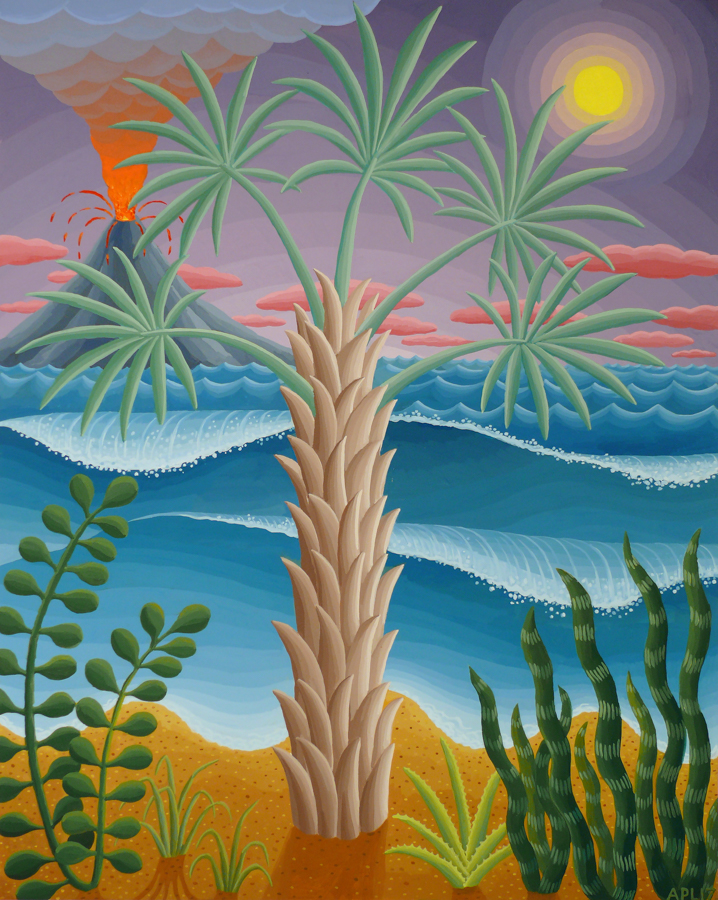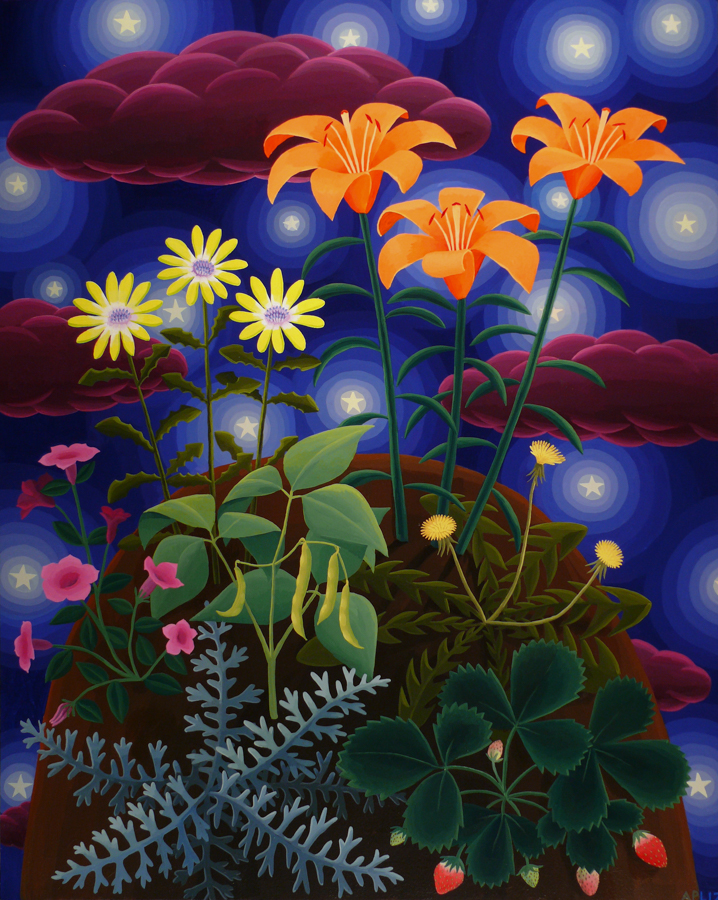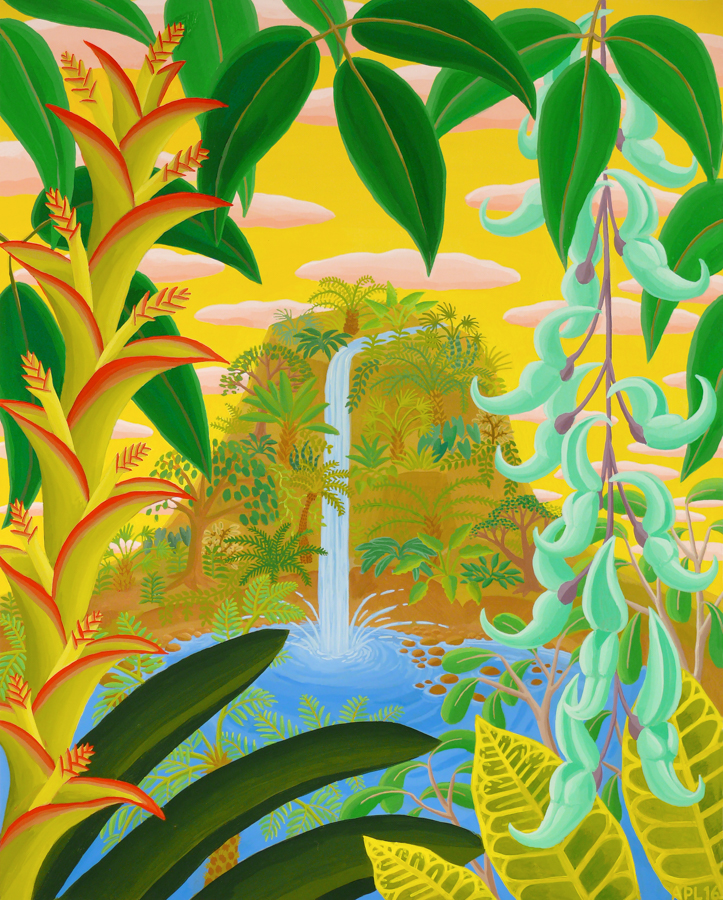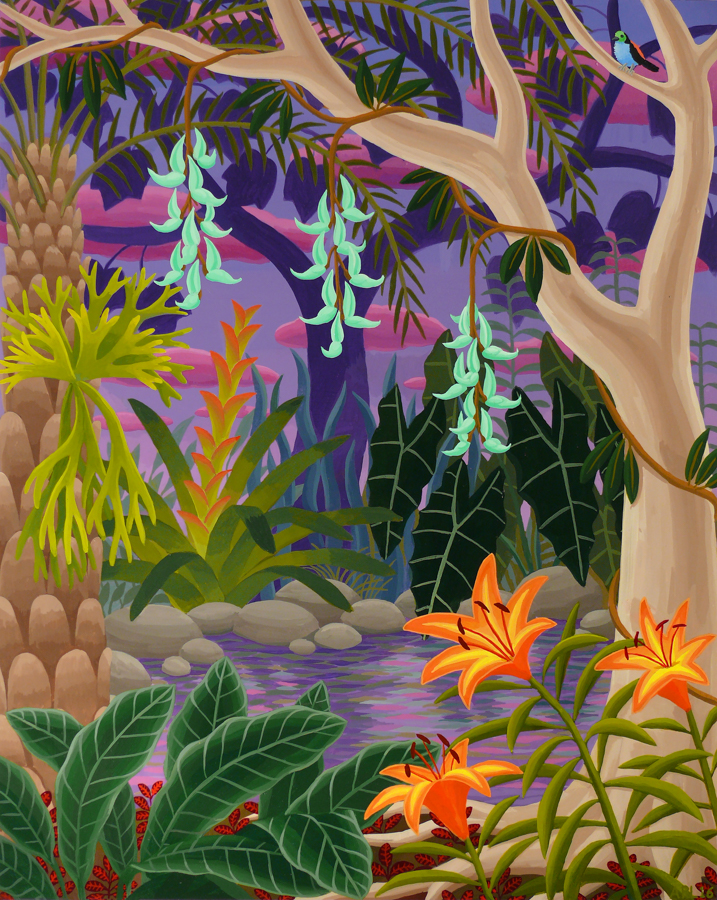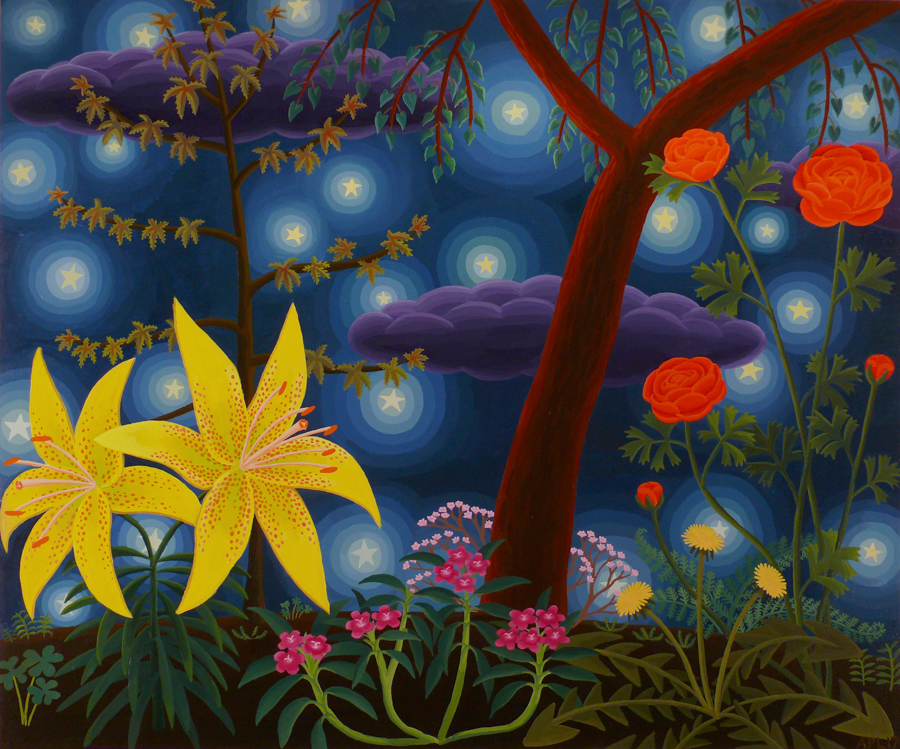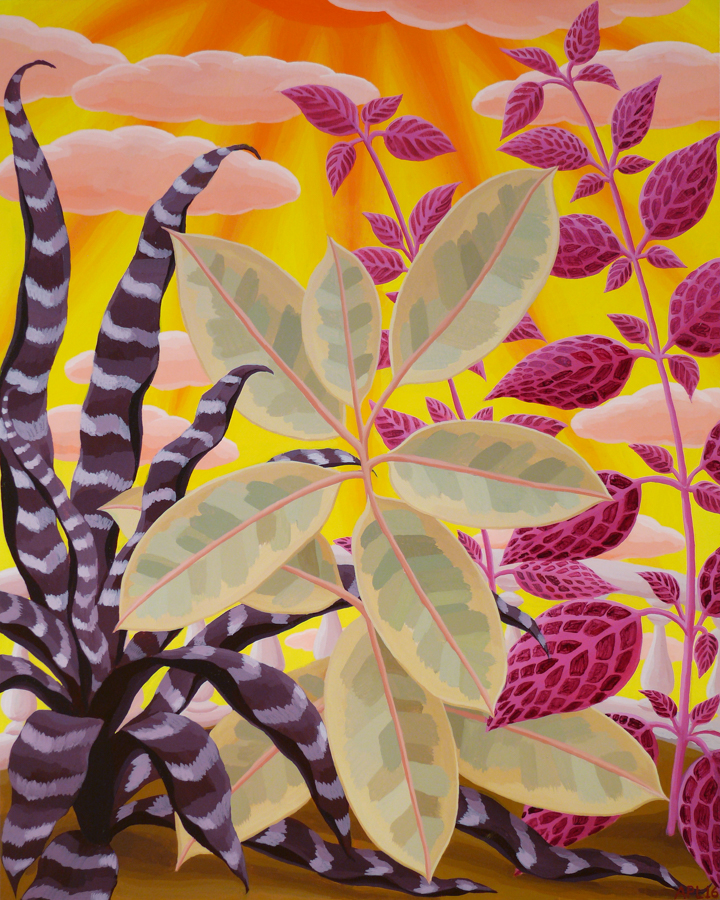Amy Lincoln
Amy Lincoln is a New York-based artist who makes carefully observed and imaginatively colored paintings of plants and the natural world. She has shown her work throughout the United States in cities such as New York, Boston, Salt Lake City, and Portland, as well as internationally in Tokyo, Paris, and Beijing. She received an MFA in Painting from Tyler School of Art in Philadelphia, and a BA in Studio Art from the University of California, Davis. Lincoln moved to New York in 2006 upon receiving a Swing Space residency from the Lower Manhattan Cultural Council. She has also participated in residencies at the Inside Out Art Museum in Beijing as well as Wave Hill in the Bronx. Lincoln grew up in the quiet, tree-lined suburbs Portland, Oregon. Today she lives in Glendale, Queens with her husband, artist Kevin Curran, and their daughter Fiona.
STATEMENT
I make still life and landscape paintings that feature closely observed representations of specific plant species. I combine the plant imagery with elements of nature such as distant mountains, fluffy clouds, sun rays, glowing moons, and twinkling stars. The plants are colorful, densely patterned, and also a little monstrous. They reach from one end of the composition to the other, overlapping and revealing unnaturally vivid skies.
Interview with Amy Lincoln
Questions by Emily Burns
Hi Amy! Have you always worked with flowers and botanical life as subject matter? What drew you to this subject initially? Were plants part of your childhood in any way?
I used to draw and paint people primarily, portraits and self-portraits. When I was in grad school I started keeping potted plants, and they occasionally made their way into my paintings. In about 2009 I got more interested in painting plants and since about 2012 plants and landscape are pretty much the only thing I paint. My mom has an incredible garden that has always been a big creative outlet for her. I think growing up next to a beautiful garden with a mom who was very enthusiastic about plants probably influenced my work.
You do some incredible things with acrylic paint. Have you always worked with acrylic? Are you blending the paint or primarily laying down successive sections of color? Is there a reason that you gravitate toward acrylic vs. oil?
Thanks! I used to work in oil, and switched to acrylic around 2007 when I had first moved to New York. I found that making really detailed paintings with bright color was hard to do with oil paint, because it dries so slowly, everything would turn grey and muddy unless I waited a long time. I mostly lay down successive sections of color, since acrylic dries so quickly that it's difficult to do a lot of blending, though there is definitely some blending. Mostly I try to make each color with very few pigment ingredients, say only yellow and black, then I know exactly how to make each color, and there aren't a lot of variables that I need to get right when recreating the color.
The color choices in the paintings are really stunning. How do you choose and mix colors?
I often try to make the color be as vivid as possible, while still modeling a form in light and dark. Color is often the starting point for each painting. I'll try to think of a color combination that I haven't used before, or think of how I can change certain colors in a landscape so that the value still makes sense for a day or night scene, but the color is something surprising. I mix the colors with a brush on a paper palette, again, using as few pigment ingredients as possible. Using few ingredients makes it easier to remember, and tends to keep the color really bright.
The paintings are extremely bright and really seem to almost glow. Do you use fluorescent paint in your color mixes?
Haha, nope! Some of the acrylic paints are a bit transparent, so I have to layer them up over a light base coat. Sometimes this effect makes the paint seem to glow. Also I try to maximize contrast within the composition, sometimes using complementary colors to make everything seem brighter—ie, yellowish green leaves in front of purple clouds.
Do you draw or sketch as part of the planning stages for the paintings?
Definitely. I usually start with drawings in a sketchbook. Then I make a study for the painting on a small panel or on watercolor paper in acrylic. Sometimes I make more than one study. Usually the final painting is quite similar to the study, with minor changes.
What is your process for a painting from beginning to final stages?
Usually I see a plant or a few plants that I'm excited by, and I think about how I can plan a composition around it/them. Usually the color of the plants is a more keyed up version of their natural color. I often come up with sky or background color ideas from something that happened in an earlier painting, some idea that I want to explore further.
Do you use references of any kind for the compositions?
The compositions are usually entirely made up. I definitely use photos for the plants. I see things when I'm out and about and photograph them with my phone. Then I figure out the name of the plant species and google it for more images. It's pretty important to experience the plant in person in order to have that initial moment of inspiration or excitement. I had a residency at Wave Hill in 2015 which gave me a ton of source material to work from. I've been to the Bronx Botanical Garden a couple times. Lately I've been drawing inspiration from the garden we created since we moved to Queens and now have a backyard.
Your recent work includes paintings that seem to be set in nighttime environments as well as daytime. Can you tell us more about the differences between the two?
I've always been drawn to nighttime scenes since I started painting the plants. I like the contrast of a dark background against a plant, because the green of most plants is dark, so it's nice to have a dark color behind it to make the plant pop out more. I like the moodiness of night paintings too. With daytime paintings my job is usually to find an interesting color for the sky. I try to avoid a blue sky with white clouds, or a plain grey cloudy sky. I want the light to feel like daytime, but the color to be surprising.
How do you choose the types of plants in each painting? Is there any significance to each type?
I'm usually inspired by plants I see in person, either that I walk past in my daily life, or I see at a garden, or while on a trip. I look for interesting patterns or plant structure.
Beyond plants as subject matter, are you a plant lover? Do you have a lot of house plants or do you garden?
Yes, sort of. But I put a lot more energy into painting plants than into caring for them though, haha. I have a bunch of house plants, and I have a garden since we moved into our new place a year and a half ago. I'm new to gardening and am not very good at it. I've been focusing on growing tomatoes, cucumber, herbs, and lettuce, which has been really great in the summer.
Each scene becomes an almost saccharine paradise or utopia—how does this effect relate to the themes in your work?
I think landscape painting can feel a bit kitschy, or cliched, tropical landscape especially. A few years ago I tried to play up the irony in the paintings to make this seem intentional. I was in Florida a couple times last year and really wanted to paint some of what I saw there, but had a hard time figuring out how to paint palm trees and beaches without it seeming like bad vacation art. I'm more interested in an older idea of the jungle as a really dense, potentially threatening place that is very far away and that I am conjuring up through imagination. I love Henri Rousseau's work, and I love that he never actually went to a tropical jungle, he just got all his source material from a botanical garden in Paris, and from books. I like the idea of a jungle as a wild, unfamiliar, potentially threatening place where animals you have only heard of and never seen might live.
What have been some of the biggest influences on your life and your work thus far?
As a kid I was really influenced by book illustrations and Disney movies. When I was deciding to become an artist, I hadn't really experienced paintings in person all that much. I was really excited by Lisa Yuskavage and Cindy Sherman when I was in college, but I was also learning to paint in a pretty traditional, realistic way. During grad school I went to the Philadelphia Museum of Art a lot and was really struck by the folk art. I realized I had to un-learn how I had learned to paint. I had to stop painting from life and start painting from memory. After that the possibilities for subject matter really opened up for me.
What is a typical day like for you?
I often wake up at 5 or so (I'm not a great sleeper) and paint for a couple of hours until my husband wakes up. We have coffee and tea together until my daughter wakes up. I get her ready and take her to daycare. From there I either go into Manhattan to work for one of my bookkeeping clients, or I go back home for a studio day. My studio is in my house so the commute is pretty easy :) At 5 I pick up my daughter, sometimes we go to the playground for an hour. Then we go home, make dinner, and if there's time we watch an hour of TV, then my husband and I put my daughter to bed and I try not to fall asleep while reading to her. I'm usually asleep by 10.
Who are some of the artists that you look at the most often or most recently?
Lately I'm mostly looking at other artists who are making work now: Matthew Fisher, Ryan Schneider, Holly Coulis, Shara Hughes, Jordan Kasey, Sascha Braunig, Nikki Maloof. I'm looking for representations of nature, and also just representations of form. Instagram has been a great way for me to discover new artists.
Is there anything that significantly supports or destroys your groove or energy in the studio?
What supports my groove: feeling rested, relaxed, having fun with friends and family, getting enough exercise, and then having studio time. What destroys my groove: feeling burned out from working really hard to finish a big project, feeling stressed out and anxious about my day job, getting interrupted multiple times throughout the day by lots of phone calls or texts. Sometimes after working extra hard to finish a show or a big project, when I try to go back to the studio right away I feel really miserable and drained. I have to spend a couple days going for walks, hanging out with friends, going to galleries, buying clothes to recharge before I can get back to work.
Has there ever been a book/essay/poem/film/etc that totally changed or influenced you? What are you reading right now?
When I discovered feminism, first through an art history class taught by a feminist art historian named Dianne Macleod, then by reading "The Second Sex" by Simone de Beauvoir, that had a huge impact on me. This gave me words to describe and understand all these uncomfortable dynamics that I had always felt but never quite rose to the level of awareness.
A more recent one, maybe not what you were looking for haha, but "The Life Changing Magic of Tidying Up" really did change my life. I have a different relationship with "stuff" now. I want to have as little stuff as possible, and I kind of can't stand being in a room that is messy or disorganized.
How important is the place where you live to your studio practice? This could include geographic location, city, neighborhood, community, etc.
I like feeling like the city is close by and accessible, but also that I'm not right in the middle of it. Being able to go into a city and experience art, culture, and fashion really inspires me. But when I'm making work I like to feel a bit removed from that. We lived in Bushwick for 7 years as it was rapidly gentrifying. In the last few years there I started feeling like I had to dress really well any time I left our apartment. All the cool new restaurants and fashionable 23 year olds were getting a little too close for comfort. My studio didn't feel as peaceful and remote as I like it to feel. I like where I live now (Glendale, Queens) because it's very peaceful, not at all hip, and kind of a long walk to the train. There are lots of trees.
Any advice from your past that has stuck with you or helped you?
I heard someone describe being an artist as following your own path and becoming more and more specific and particular. I like that idea of the goal of being an artist as carving out your own territory and becoming as idiosyncratic within the work as possible.
Do you have any other news, shows, residencies or projects coming up?
I'm working on a big commission for a corporation. It's the biggest painting I've ever done at 18 feet wide by 5 feet tall. I can't reveal more until it's finalized though. Hopefully I can confirm in a couple weeks!
Thank you so much for taking the time to talk with us!
Thank you!!!
To find out more about Amy and her work, check out her website.

